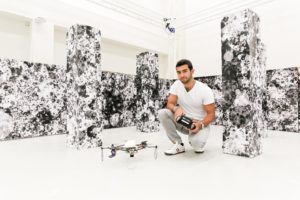
Insects may help a renowned Swiss research institute envision ways to improve drone navigation while also saving some lives in the process.
Darius Merk, a physics student at École Polytechnique Fédérale in Lausanne has developed an algorithm that could help drones better avoid obstacles and navigate in difficult environments to help reach victims of natural disasters.
The drone, developed as a master’s project at EPFL’s Laboratory of Intelligent Systems, can “see” via a multi-faceted vision system much like an insect and is autonomous.
“Using cameras to simulate the human eye requires a lot of computing power,” Merk said in an EPFL press release. “For this, the drone would need to have a small on-board computer, which would make it difficult to miniaturize.”
“The drone is light, autonomous and capable of getting round obstacles – it will be able to follow a programmed course in order to bring back videos and images of areas that are hard to reach,” an EPFL spokesperson stated. “The technology would be extremely handy in a natural disaster, as it could be used to help rescuers and to scout the terrain.”
Since the drone will view reality like an insect, Merk says it will only require two 15g cameras to produce a 360-degree view. “Insects find their way by using their optical flow to assess how an image moves, with a distant object moving more slowly than a closer one,” he said. Merk added that the drone would not use much computing power and finished models would only measure around 4 inches in diameter.
EPFL, an institute that specializes in engineering and physical sciences, has already made major strides in drone research. Earlier this year, researchers tested a crowd-sourcing platform that allowed volunteers to evaluate some 26,000 images taken by drones over the Kuzikus wildlife reserve in Namibia. Within two days, the platform processed 98 percent of the annotated images including hundreds of wildlife and flora that can be hard to distinguish by recognition software. Once processed, the drone can use the improved data provided by the algorithm.
Jason is a longstanding contributor to DroneLife with an avid interest in all things tech. He focuses on anti-drone technologies and the public safety sector; police, fire, and search and rescue.
Beginning his career as a journalist in 1996, Jason has since written and edited thousands of engaging news articles, blog posts, press releases and online content.
Email Jason
TWITTER:@JasonPReagan
Subscribe to DroneLife here.







[…] https://dronelife.com/2016/09/02/insect-inspired-research-may-improve-rescue-drones/ […]